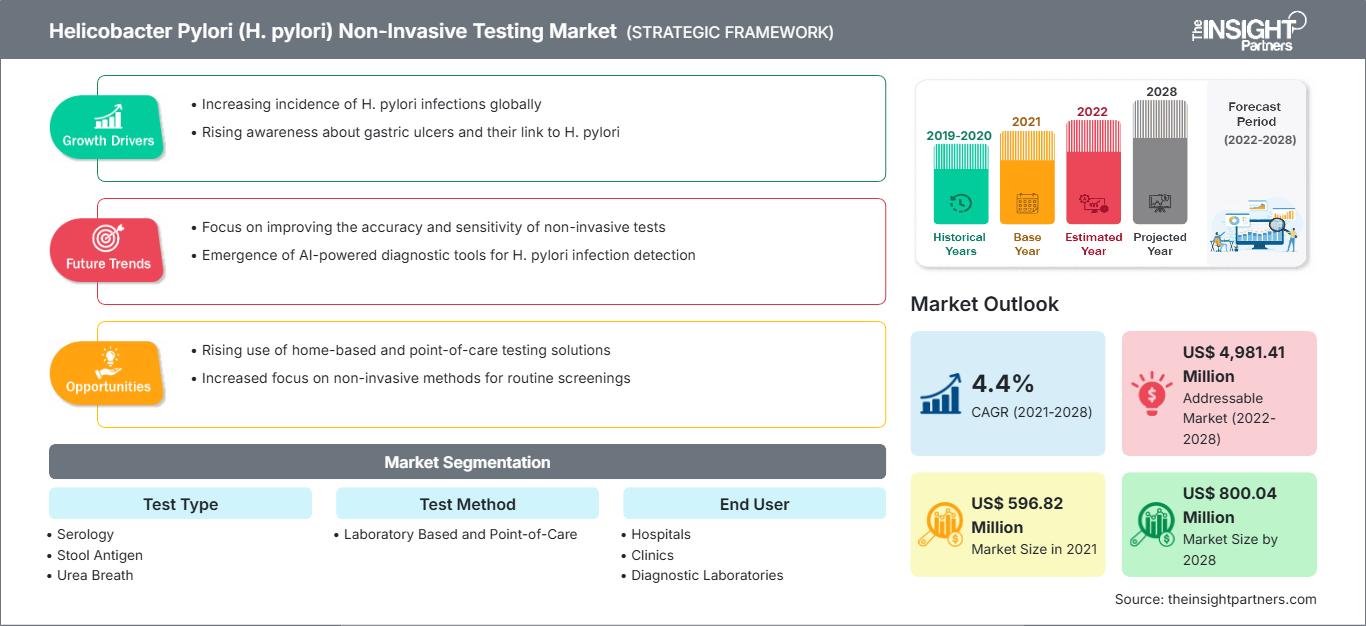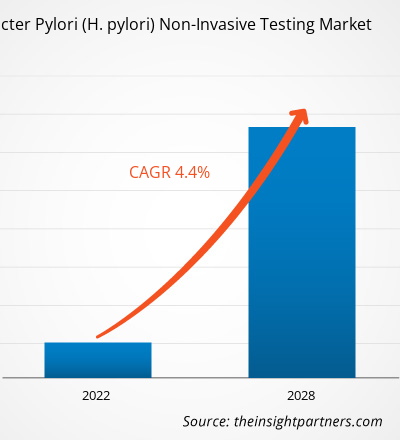Si prevede che il mercato dei test non invasivi per l'Helicobacter Pylori (H. pylori) crescerà da 596,82 milioni di dollari nel 2021 a 800,04 milioni di dollari entro il 2028; si stima una crescita a un CAGR del 4,4% dal 2022 al 2028.
La crescente prevalenza dell'infezione da H. pylori e i progressi tecnologici stanno guidando la crescita complessiva del mercato. Inoltre, le strategie implementate dai principali attori offrono opportunità redditizie nel mercato globale.
L'Helicobacter Pylori (HP) è un fattore importante responsabile dell'ulcera peptica e della gastrite. Secondo il rapporto della Public Library of Science (PLOS), circa un terzo degli adulti nel Nord Europa e nel Nord America è infetto da HP, con una prevalenza molto elevata in Africa, Sud e Africa. America Centrale, Asia ed Europa meridionale e orientale rappresentano il 50%. Inoltre, l'infezione da HP è elevata tra gli adulti, con alcune variazioni geografiche. Ad esempio, il rapporto del National Institute of Health (NIH) afferma che l'infezione da H. pylori tra gli adolescenti è del 30-50% e, tra gli adulti, raggiunge il 90% nei paesi in via di sviluppo.
Il rapporto del Clinical and Experimental Pediatrics (CEP) afferma che la prevalenza dell'infezione da H. pylori è diminuita. Sebbene il tasso di infezione da H. pylori sia diminuito in Corea del Sud e nei paesi sviluppati, il 33% dei bambini asintomatici o sani è ancora sierologicamente infetto in tutto il mondo, secondo lo stesso rapporto. Ad esempio, paesi sviluppati come Giappone, Germania, Paesi Bassi e Stati Uniti hanno registrato una bassa sieroprevalenza, pari rispettivamente al 7,7%, 11,8%, 9,8% e 5,7% nel 2020. Tuttavia, tassi di infezione elevati, pari rispettivamente al 27,2%, 65,9%, 25,8% e 40,4%, sono stati segnalati nello stesso anno in Cile, Venezuela, Iran e Nigeria. Pertanto, la crescente prevalenza dell'infezione da H. pylori accelera la domanda di test non invasivi, alimentando in ultima analisi la crescita del mercato dei test non invasivi per l'Helicobacter Pylori (H. pylori) durante il periodo di previsione.
Personalizza questo rapporto in base alle tue esigenze
Potrai personalizzare gratuitamente qualsiasi rapporto, comprese parti di questo rapporto, o analisi a livello di paese, pacchetto dati Excel, oltre a usufruire di grandi offerte e sconti per start-up e università
Mercato dei test non invasivi per l'Helicobacter Pylori (H. pylori): Approfondimenti strategici

-
Ottieni le principali tendenze chiave del mercato di questo rapporto.Questo campione GRATUITO includerà l'analisi dei dati, che vanno dalle tendenze di mercato alle stime e alle previsioni.
L'Helicobacter Pylori (H. pylori) è un'infezione batterica che viene rilevata principalmente nei pazienti affetti da ulcere gastriche e duodenali. Ad esempio, il rapporto dei Centers for Disease Control and Infection (CDC) afferma che la prevalenza dell'infezione da H. pylori a livello mondiale è di circa il 50% e di circa l'80-90% nei paesi in via di sviluppo. Inoltre, la prevalenza di H. pylori è stimata al 35-40% negli Stati Uniti. L'elevata prevalenza dell'infezione da H. pylori influenza positivamente l'adozione di soluzioni diagnostiche non invasive. I progressi tecnologici e le innovazioni nelle soluzioni di test non invasivi per l'H. pylori offrono risultati accurati e una maggiore soddisfazione del paziente affetto da infezione batterica. Ad esempio, i test point-of-care (POCT) forniscono risultati accurati a un prezzo accessibile in breve tempo. Poiché le persone con più patologie sono solitamente più vulnerabili alle infezioni e cercano una diagnosi precoce dell'H. pylori, la maggiore accessibilità al POCT e la facile disponibilità di numerosi dispositivi invasivi e non invasivi hanno un impatto positivo sulla crescita del mercato. Ad esempio, a maggio 2022, Biomerica, Inc. ha annunciato il lancio di un nuovo prodotto per il marchio CE per il suo test diagnostico "hp+detect", responsabile della rilevazione del batterio H. pylori. Il nuovo prodotto "hp+detect" è responsabile della rilevazione del batterio H. pylori, con una prevalenza del 35% nella popolazione statunitense e del 45% nei cinque paesi più grandi d'Europa. Il basso tasso di diagnosi rappresenta un importante freno per il mercato dei test non invasivi per l'Helicobacter pylori (H. pylori). Un basso status socioeconomico o un basso livello di istruzione sono associati a una maggiore prevalenza dell'infezione da H. pylori. In Australia, il pool di dati sull'H. La prevalenza stimata di Helicobacter pylori nella popolazione generale era del 24,6%, ma ha registrato una prevalenza del 76,0% nella comunità indigena rurale dell'Australia Occidentale. Negli Stati Uniti, la prevalenza complessiva di Helicobacter pylori stimata nella popolazione generale era del 35,6%; tuttavia, nella popolazione indigena dell'Alaska, era del 74,8%. L'infezione da Helicobacter pylori (H. pylori) è elevata perché rimane asintomatica per un periodo prolungato, quindi il tasso di diagnosi è basso per questa infezione. La maggior parte delle persone con infezione da H. pylori è asintomatica. Questo problema può ritardare la diagnosi dell'infezione, limitando la domanda di kit di test non invasivi.
Mercato dei test non invasivi per l'Helicobacter Pylori (H. pylori) - Panoramica regionale
La Cina detiene una quota considerevole nel mercato dei test non invasivi per l'Helicobacter pylori (H. pylori) nell'area Asia-Pacifico. La Cina è un paese in via di sviluppo nell'area Asia-Pacifico con un sistema sanitario consolidato e un'industria farmaceutica in rapida crescita. La Cina ospita diverse aziende produttrici di prodotti medici, farmaceutici e biotecnologici che operano sul mercato globale. Queste aziende farmaceutiche e biotecnologiche sono coinvolte nello sviluppo di vari kit e dispositivi di test per la rilevazione dell'H. pylori a causa dell'elevata prevalenza di varie infezioni da H. pylori e di casi di cancro gastrico (allo stomaco), che stimola la crescita del mercato.
Il Giappone è uno dei paesi leader con l'industria medica più avanzata. Secondo il Roswell Park Comprehensive Cancer Center, in Giappone si registrano tassi sproporzionatamente elevati di casi di cancro allo stomaco a causa dell'elevata incidenza di infezioni da H. pylori e dell'elevato consumo di cibi affumicati e salati. Inoltre, il cancro gastrico è il terzo tumore più mortale, con circa 50.000 decessi ogni anno in Giappone. Inoltre, secondo uno studio (2020) pubblicato sulla Wiley Online Library, H. pylori causa circa il 98% dei casi di cancro gastrico in Giappone. Sebbene siano state segnalate numerose cause di cancro gastrico, studi recenti hanno dimostrato che la maggior parte dell'incidenza del cancro gastrico è dovuta all'infezione causata da H. pylori. Si prevede che i fattori sopra menzionati avranno un impatto positivo sulla crescita del mercato dei test non invasivi per l'Helicobacter pylori (H. pylori) in Giappone durante il periodo di previsione.
Mercato dei test non invasivi per l'Helicobacter Pylori (H. pylori) - Approfondimenti basati sulla tipologia di test
In base alla tipologia di test, il mercato dei test non invasivi per l'Helicobacter Pylori (H. pylori) è segmentato in sierologia, antigene fecale e test del respiro all'urea. Si stima che il segmento del respiro all'urea detenga la quota di mercato maggiore e il CAGR più elevato dal 2022 al 2028. Secondo il rapporto del National Institute of Health (NIH), i test diagnostici non invasivi per l'H. pylori sono disponibili per il point-of-care (POC) destinati all'assistenza primaria, utilizzando la sierologia IgG, il test del respiro all'urea (UBT) e l'antigene fecale monoclonale. Tra questi, solo l'UBT garantisce accuratezza nel confermare l'infezione in corso o l'eradicazione. Il rapporto Gut and Liver mostra che l'UBT è non invasivo e accurato, garantendo sicurezza nei pazienti pediatrici e nelle donne in gravidanza. Pertanto, è probabile che i fattori sopra menzionati stimolino la crescita del mercato per questo segmento dal 2022 al 2028.
Le aziende che operano nel mercato dei test non invasivi per l'Helicobacter Pylori (H. pylori) adottano una strategia di innovazione di prodotto per soddisfare le esigenze in continua evoluzione dei clienti in tutto il mondo, il che consente loro anche di mantenere il proprio marchio sul mercato.
Mercato dei test non invasivi per l'Helicobacter Pylori (H. pylori) - Segmentazione
In base alla tipologia di test, il mercato dei test non invasivi per l'Helicobacter Pylori (H. pylori) è segmentato in sierologia, antigene fecale e test dell'alito ureico. Il segmento dell'alito all'urea ha rappresentato la quota di mercato maggiore nel 2021 e si prevede che registrerà il CAGR più elevato dal 2022 al 2028. In base al metodo di test, il mercato è suddiviso in test di laboratorio e point-of-care. Il segmento dei test di laboratorio ha guidato il mercato nel 2021 e si prevede che manterrà la sua posizione dominante durante il periodo di previsione. In base all'utente finale, il mercato è segmentato in ospedali, cliniche e laboratori diagnostici. Il segmento degli ospedali ha guidato il mercato nel 2021 e si prevede che manterrà la sua posizione dominante durante il periodo di previsione. In base all'area geografica, il mercato è segmentato principalmente in Nord America, Europa, Asia-Pacifico, Medio Oriente e Africa e Sud e Centro America.
Approfondimenti regionali sul mercato dei test non invasivi per l'Helicobacter Pylori (H. pylori)
Le tendenze regionali e i fattori che influenzano il mercato dei test non invasivi per l'Helicobacter Pylori (H. pylori) durante il periodo di previsione sono stati ampiamente spiegati dagli analisti di The Insight Partners. Questa sezione illustra anche i segmenti e la distribuzione geografica del mercato dei test non invasivi per l'Helicobacter Pylori (H. pylori) in Nord America, Europa, Asia-Pacifico, Medio Oriente e Africa, America Meridionale e Centrale.
Ambito del rapporto di mercato sui test non invasivi per l'Helicobacter Pylori (H. pylori)
| Attributo del rapporto | Dettagli |
|---|---|
| Dimensioni del mercato in 2021 | US$ 596.82 Million |
| Dimensioni del mercato per 2028 | US$ 800.04 Million |
| CAGR globale (2021 - 2028) | 4.4% |
| Dati storici | 2019-2020 |
| Periodo di previsione | 2022-2028 |
| Segmenti coperti |
By Tipo di test
|
| Regioni e paesi coperti |
Nord America
|
| Leader di mercato e profili aziendali chiave |
|
Densità degli operatori del mercato dei test non invasivi per l'Helicobacter Pylori (H. pylori): comprendere il suo impatto sulle dinamiche aziendali
Il mercato dei test non invasivi per l'Helicobacter Pylori (H. pylori) è in rapida crescita, trainato dalla crescente domanda degli utenti finali dovuta a fattori quali l'evoluzione delle preferenze dei consumatori, i progressi tecnologici e una maggiore consapevolezza dei benefici del prodotto. Con l'aumento della domanda, le aziende stanno ampliando la propria offerta, innovando per soddisfare le esigenze dei consumatori e sfruttando le tendenze emergenti, alimentando ulteriormente la crescita del mercato.

- Ottieni il Mercato dei test non invasivi per l'Helicobacter Pylori (H. pylori) Panoramica dei principali attori chiave
Mercato dei test non invasivi per l'Helicobacter Pylori (H. pylori) - Profili aziendali
- DiaSorin SpA,
- Meridian Bioscience, Inc.,
- QuidelOrtho Corporation,
- Abbott Laboratories,
- Thermo Fischer Scientific,
- CerTest Biotec,
- Sekisui Diagnostics,
- Coris BioConcept,
- Shenzhen Zhonghe Headway Bio-Sci & Tech Co., Ltd.,
- Bio-Rad Laboratories, Inc.
- Analisi storica (2 anni), anno base, previsione (7 anni) con CAGR
- Analisi PEST e SWOT
- Valore/volume delle dimensioni del mercato - Globale, Regionale, Nazionale
- Industria e panorama competitivo
- Set di dati Excel
Report recenti
Testimonianze
Motivo dell'acquisto
- Processo decisionale informato
- Comprensione delle dinamiche di mercato
- Analisi competitiva
- Analisi dei clienti
- Previsioni di mercato
- Mitigazione del rischio
- Pianificazione strategica
- Giustificazione degli investimenti
- Identificazione dei mercati emergenti
- Miglioramento delle strategie di marketing
- Aumento dell'efficienza operativa
- Allineamento alle tendenze normative






















 Ottieni un campione gratuito per - Mercato dei test non invasivi per l'Helicobacter Pylori (H. pylori)
Ottieni un campione gratuito per - Mercato dei test non invasivi per l'Helicobacter Pylori (H. pylori)